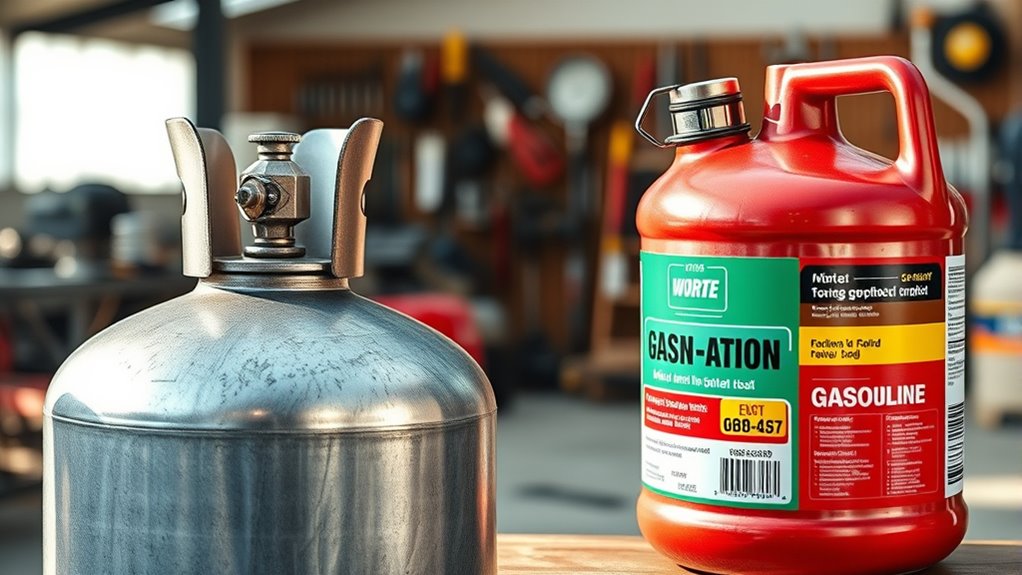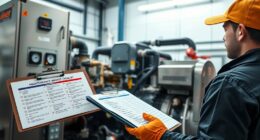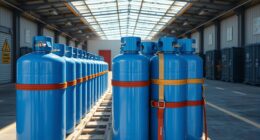To distinguish propane from gasoline in runtime, remember that gasoline offers longer operation times because of its higher energy density and easy storage. Propane, while safer and cleaner burning, typically provides shorter runtimes due to less energy per volume. Factors like temperature, equipment efficiency, and storage conditions also influence how long each fuel lasts. Continue exploring to understand how to maximize your equipment’s safety, efficiency, and runtime with each fuel type.
Key Takeaways
- Gasoline generally provides longer runtime due to higher energy density and easier storage for portable applications.
- Propane offers shorter, more consistent runtime with safer storage but requires larger tanks for extended use.
- Cold weather affects fuel efficiency: gasoline may gel, while propane’s vaporization decreases, impacting runtime.
- Safety considerations: propane is safer to handle and store but requires proper precautions; gasoline is more volatile and flammable.
- Operational needs and environment determine the best fuel choice, balancing runtime, safety, storage, and cost factors.
How Do Propane and Gasoline Differ in Energy Content?
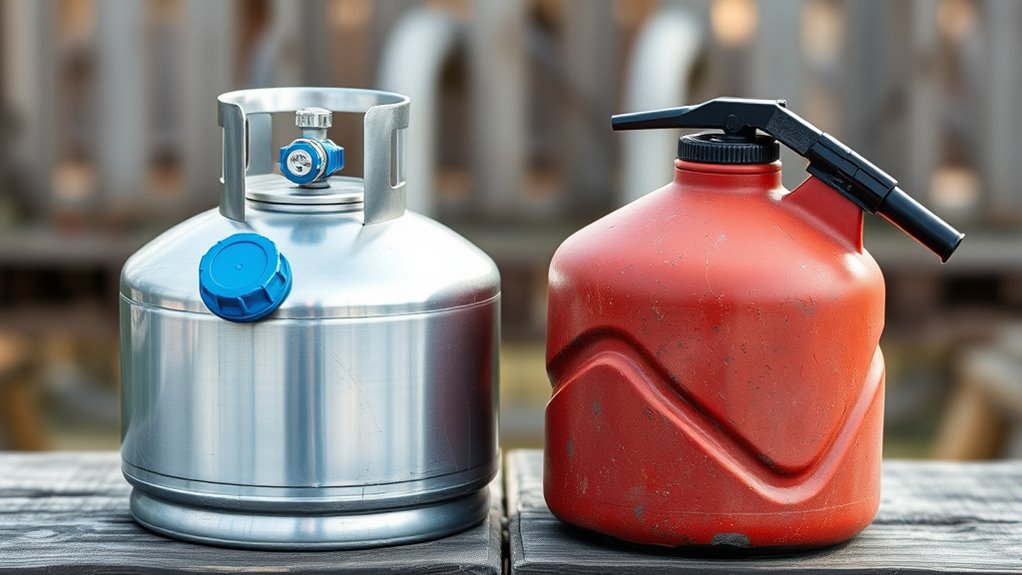
Propane and gasoline differ markedly in their energy content, which directly affects how long they can power equipment. Propane has a lower energy density than gasoline, meaning it provides less energy per unit volume. This influences storage safety since propane is stored as a pressurized gas, requiring secure tanks to prevent leaks and explosions. Gasoline, on the other hand, is liquid at ambient temperature but poses a higher environmental impact if spilled, contaminating soil and water. When choosing between these fuels, consider not just runtime but also storage safety and environmental impact. Propane’s cleaner burn produces fewer emissions, making it a better choice for environmentally conscious users. Additionally, the flammability and storage of propane require careful handling to prevent accidents. Understanding these differences helps you optimize safety and minimize environmental risks while managing your fuel supplies effectively.
Which Fuel Offers Longer Operating Times for Portable Equipment?

When comparing fuel options for portable equipment, gasoline generally offers longer operating times than propane due to its higher energy density. Gasoline’s compact fuel storage means you can carry more energy in less space, resulting in extended runtime. However, consider the environmental impact—gasoline produces more emissions than propane, which is cleaner burning. To help visualize, here’s a quick comparison:
| Fuel Type | Fuel Storage | Runtime Potential |
|---|---|---|
| Gasoline | Denser, more stored per volume | Longer, ideal for extended use |
| Propane | Portable tanks, less storage | Shorter, suited for quick tasks |
While gasoline offers longer operating times, propane’s cleaner burn makes it preferable for environmentally conscious users.
What Factors Influence Runtime Differences Between Propane and Gasoline?
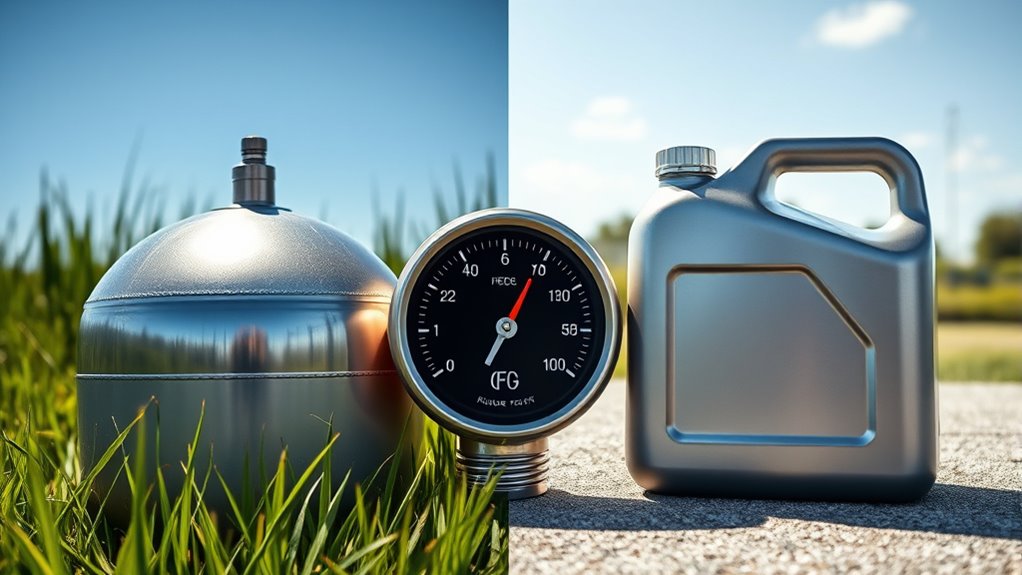
Several factors determine the runtime differences between propane and gasoline in portable equipment. Storage temperature plays a key role—lower temperatures can cause both fuels to become less volatile, reducing engine efficiency. Propane is stored under pressure as a liquid, so extreme cold may decrease flow rate, impacting runtime. Gasoline’s performance can also decline in cold weather due to thickening or gelling. Ambient humidity influences fuel quality; high humidity can introduce moisture into gasoline, leading to poor combustion and shorter runtime. Propane, being a dry gas, isn’t affected by humidity in the same way. Additionally, storage conditions impact fuel stability, affecting how efficiently your equipment runs over time. Speaks 4 Me Online emphasizes that understanding industry trends and proper maintenance can optimize fuel performance and prolong runtime. Overall, environmental factors like storage temperature and humidity considerably influence how long each fuel lasts during operation.
How Does Equipment Efficiency Vary When Using Propane Vs Gasoline?
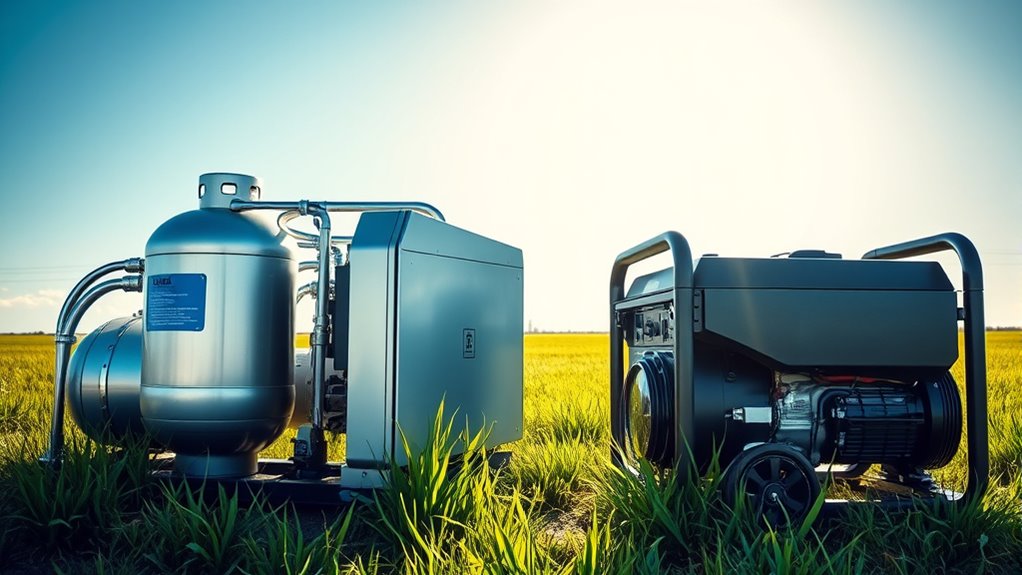
Equipment efficiency varies markedly between propane and gasoline, primarily due to how each fuel combusts within the engine. Propane burns cleaner, resulting in less engine wear and often higher efficiency over time. Its fuel storage tends to be more stable and safer, reducing leaks and spills that could impact performance. Gasoline, on the other hand, may deliver more immediate power but can degrade faster, affecting efficiency. Additionally, propane’s lower environmental impact means fewer emissions, which can help your equipment operate more smoothly and sustainably. The differences in fuel storage requirements and combustion characteristics directly influence how effectively your equipment runs on each fuel. Moreover, regional legal regulations can influence fuel choices and operational considerations. Overall, understanding these factors helps you choose the most efficient fuel for your specific needs.
Are There Safety Considerations That Affect Runtime Choices?
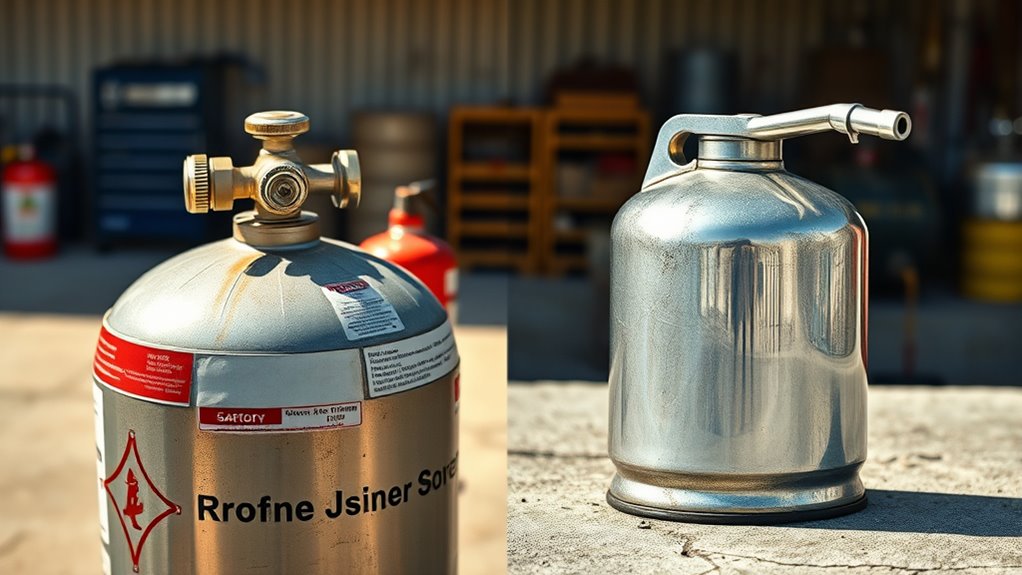
Safety considerations play a essential role in choosing between propane and gasoline for your equipment, as each fuel presents distinct risks that can impact runtime and overall operation. Propane is less likely to spill and leak, reducing fire hazard concerns, but it’s highly flammable and requires proper storage safety measures. Gasoline, on the other hand, poses a higher fire hazard due to its volatility and tendency to evaporate quickly, demanding careful handling and storage. You must consider how you store each fuel—propane tanks need ventilation and secure placement, while gasoline containers should be kept away from heat sources. These safety factors influence your decision, as they affect not just operational safety but also the practicality of fueling and maintaining your equipment during extended use. Proper tracking and testing of fuel safety protocols can further mitigate risks during prolonged operation.
How Can I Calculate the Expected Runtime for My Specific Equipment?
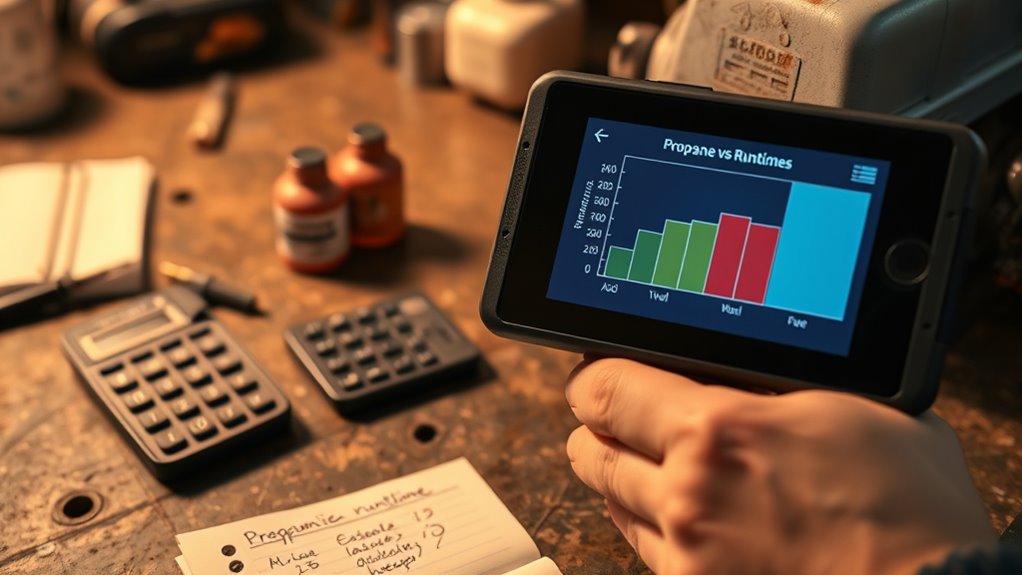
To estimate your equipment’s runtime, you need to find out how much fuel it consumes per hour. Measure its power usage to understand how quickly it uses fuel, whether propane or gasoline. With these details, you can calculate how long your equipment will run on a full tank. Additionally, considering air quality factors can help you determine the appropriate size and type of fuel or appliance for your needs.
Determine Fuel Consumption Rates
Understanding how much fuel your equipment consumes is essential for estimating runtime accurately. To do this, start by checking your equipment’s specifications or user manual for its fuel consumption rate, usually expressed in gallons per hour. Conduct a simple fuel cost analysis by noting current fuel prices and calculating how long your equipment runs on a specific tank. This process can be simplified by using digital tools or apps designed for fuel efficiency tracking, which help monitor consumption patterns over time. Additionally, understanding fuel consumption rates reveals the environmental impact, as higher consumption often means more emissions. Keep track of actual usage during typical operation to refine your estimates. By accurately measuring your equipment’s fuel consumption, you can better predict runtime, control costs, and minimize your environmental footprint.
Measure Equipment Power Usage
Calculating your equipment’s expected runtime begins with measuring its power usage. Start by checking the wattage or fuel consumption rate listed on your equipment’s label or manual. This helps you understand how much fuel energy it consumes per hour, which is vital for estimating runtime. Consider your fuel storage capacity and how quickly your equipment uses fuel, whether propane or gasoline, to gauge operation time accurately. Keep in mind, emission levels vary with fuel type and impact environmental considerations. Using this data, divide your fuel capacity by the consumption rate to determine runtime. Additionally, understanding the types of air purifiers can help you select the most efficient model for your needs, further optimizing your equipment’s performance. This method provides a clear estimate tailored to your specific equipment, helping you plan refueling and minimize downtime efficiently.
Frequently Asked Questions
How Does Ambient Temperature Impact Propane and Gasoline Runtimes?
Ambient temperature impacts propane and gasoline runtimes because it affects fuel vaporization and combustion efficiency. In colder temperatures, propane’s vaporization slows, reducing combustion efficiency and shortening runtime. Gasoline may also experience slight efficiency drops, but less dramatically. Warmer temperatures improve vaporization for both fuels, boosting combustion efficiency and extending runtimes. You’ll notice better performance in moderate to warm environments, while cold conditions can cause noticeable decreases in runtime for propane more than gasoline.
Do Different Equipment Models Affect Fuel Efficiency and Runtime?
Different equipment models markedly influence fuel efficiency and runtime, like cars with varying engines and gears. You’ll notice that equipment compatibility and model variations act as the blueprint for performance; some models optimize fuel use while others drain it faster. By choosing the right model for your needs, you guarantee your fuel lasts longer and your equipment runs smoothly, giving you confidence in every task.
Can Fuel Quality Variations Change Expected Runtime Durations?
Yes, fuel quality variations can change expected runtime durations. Fuel contamination from dirt, water, or impurities can clog filters and reduce efficiency, while poor storage conditions, like exposure to heat or moisture, degrade fuel quality over time. This results in inconsistent performance and shorter runtimes. To maximize runtime, always store fuel properly in sealed containers and use fresh fuel, avoiding contamination and deterioration.
Are There Environmental Factors Influencing Fuel Consumption Rates?
Environmental factors like temperature and humidity can influence your fuel consumption rates. For example, extreme cold may reduce fuel efficiency, while high humidity affects combustion. Fuel additive effects can help improve performance under these conditions. Additionally, proper storage conditions, such as keeping fuel in a cool, dry place, prevent degradation and guarantee consistent runtime. Being mindful of these factors helps you optimize fuel use and maintain efficiency.
How Does Maintenance Frequency Influence Actual Runtime Performance?
Think of your engine as a garden; regular maintenance is the watering that keeps it thriving. When you stay consistent, it prevents fuel contamination and maintains storage stability, ensuring your engine runs smoothly. Skipping maintenance is like letting weeds take over—performance drops, and runtime shortens. Frequent checks and cleanings help sustain maximum performance, so your engine’s runtime stays long and reliable, like a well-tended garden in full bloom.
Conclusion
Choosing between propane and gasoline is like picking the right fuel for your journey—each has its own path. By understanding their energy content, efficiency, and safety factors, you can navigate runtime differences with confidence. Think of it as tuning your engine for peak performance, ensuring your equipment runs smoothly like a well-oiled machine. When you know the facts, you steer your power source toward maximum duration, keeping your projects moving forward without missing a beat.
